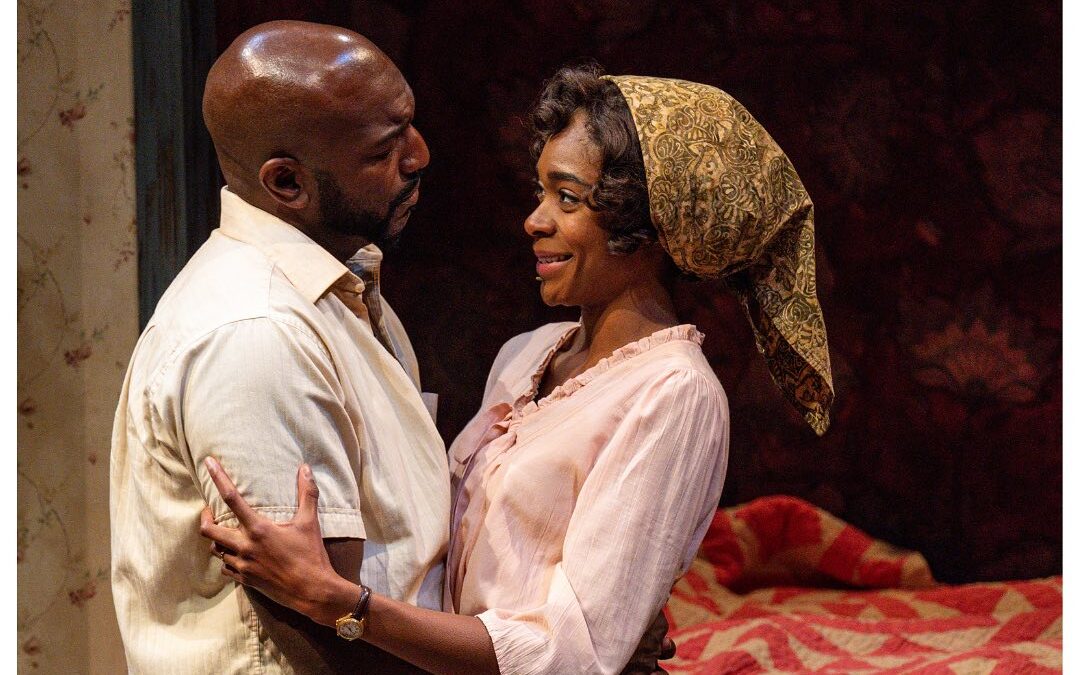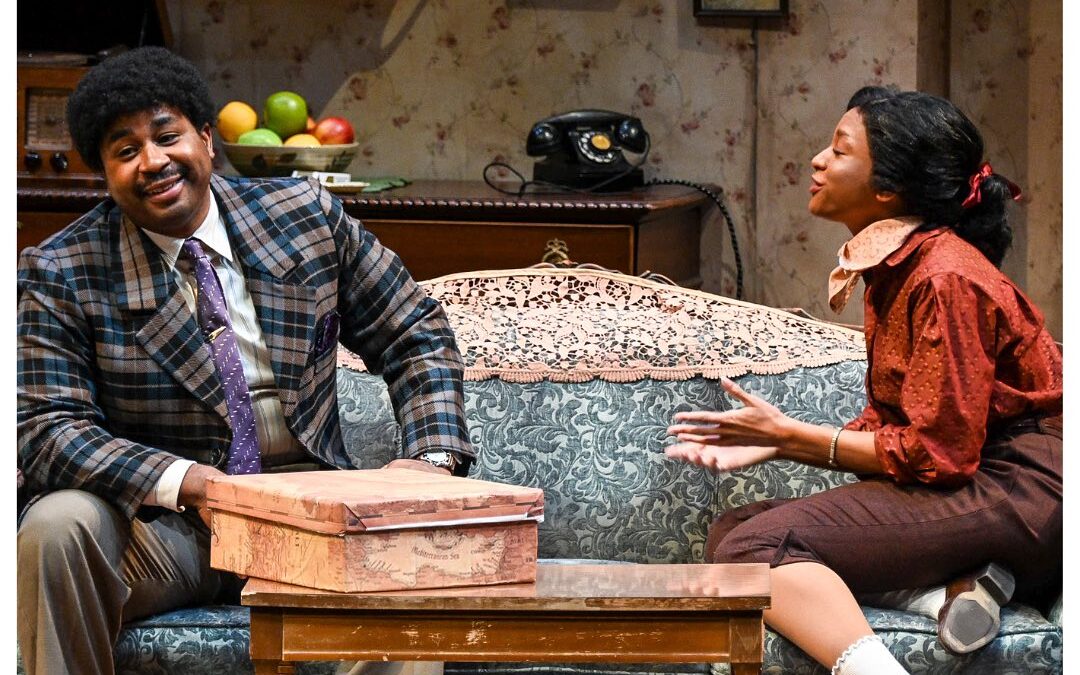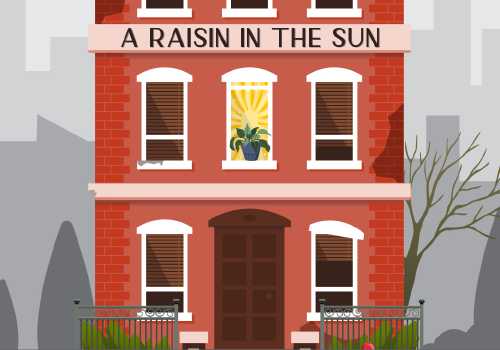By Alayna Een and Eliza Een, Front Row Reviewers
The Utah Shakespeare Festival welcomes you into the small apartment of the Younger family in its production of the classic American drama by Lorraine Hansberry, A Raisin in the Sun. The play takes its name from the classic Langston Hughes poem “Harlem” and speaks to both the American experience and specifically to the Black experience.
The story focuses on three generations of a Black family living in Chicago in the mid 1950s. The play begins in medias res with the family eagerly awaiting the arrival of a life insurance check for Mr. Younger, who has passed away. Each family member has a different idea of how to spend the $10,000 to shape and fulfill their dreams of the future. Mamma (Lena) dreams of a home in a nice neighborhood but her son Walter yearns to join the business world as an investor. Fulfilling one person’s dream means suffocating the hopes of the other. The pressure mounts, obstacles arise, and relationships reach the breaking point until a final climax settles the family and restores some of the former hope.
In this one-room drama, every adult family member experiences both sides of the spectrum of human emotion, facing disappointment and pain as well as exquisite joy and many feelings in between. But these emotions manifest differently in each character—a testament both to the excellent writing of Hansberry and the incredible talent of the cast. As the undisputed leader of the Younger clan, Monique Gaffney (Lena Younger or Mama) directs the lives of her family. But as the plot continues, she relinquishes some of that power and accepts her family members’ decisions on key matters without losing personal strength. Gaffney’s Lena is dignified and commands respect while still showing soft sides for her grandson, her children’s dreams, and her resilient house plant.

Corey Jones (Walter Lee Younger) is the heated and defeated male lead. In his moments of stubbornness and passion, he fills the whole stage; when he is down and subjugated he is still and cool as marble. Jones and Kayland Jordan (Ruth Younger) portray an achingly real couple dynamic with chemistry in playful moments and painful longing in others. Jordan’s Ruth has clearly integrated into the family unit and functions, in some ways, as a middle child in Mama’s domain. In the moments of desperation for her character, Jordan shrinks in on herself and takes on a haunted emptiness that deepens even the scenes where she is not the central focus.
The youngest Younger is Travis (Dylan Nelson/Alyvia Ridgel), the child of Walter and Ruth. Nelson/Ridgel has tender moments with Lena and Walter that further demonstrate the family’s closeness and remind them of the future that they’re working for. Beneatha Younger (Maureen Azzun) is a dream-driven student whose new ideas and too-quick tongue cause friction between family members. Azzun’s Beneatha has a rock-solid resolve and way of expressing herself but she pairs this severity with a delightfully girlish charm, dancing in front of the mirror and flirting with her would-be suitors: the suave but shallow George Murchison (Jeffrey Marc Alvins) and the jolly, ideal-driven immigrant Joseph Asagai (Dylan J. Fleming). Alvins’ Murchison is appropriately aloof and entitled and Fleming’s Asagai is genuine and endearing.

Nazlah Black (Mrs. Johnson) plays everyone’s least favorite neighbor. Black captures the paradox of being impolite while following the rules of etiquette required of a visitor and provides an insight into the community’s response to the Younger family’s decisions. Continuing with the outside perspective is Blake Henri (Karl Lindner). A born salesman, Henri feeds the Youngers the bitter pill of their future community’s disapproval of their presence with honey-coated layers of hedging and false friendship. Henri’s delivery and discomfort were both comedic and poignant. Topher Embrey (Bobo) is the bearer of bad news for Walter’s investment, and never have I seen a large man look so small and distraught.
Engaging with themes of racism, classism, prejudice within and outside of a community of belonging, and family strife, Raisin in the Sun provides plenty of food for thought, and it is carefully and lovingly put together by the production crew. Derek Charles Livingston (director) makes it feel like the story of a family and a home. I love the detail that there is always someone in the living room (both between scenes and at the beginning and end of acts) and the only time the stage is empty is in the final scene of the show—which makes perfect sense in a crowded apartment where everyone is so closely involved in each others’ lives. The focus is well imagined and well executed, especially in Jason Lajka’s (scenic designer) set. The Younger apartment is the whole world of the play, run down and dingy in a way that communicates the moments lived inside these walls and the desire to move on—in more ways than one.
ArianMarie Moye (costume designer) makes the costuming of the everyday clothes of a 1950s family look deceptively simple, with a wardrobe for each character that matches their needs and means. William Kirkham’s lighting choices during the scenes and in scene changes and intermission create consistency as the story unfolds; the light creeping through the kitchen window and table lamps follow a logic that grounds each scene. The transition between screens and acts is expertly done, with a brief moment of blackness and then an immediate lead into the scene with an onstage actor.
The Utah Shakespeare Festival provides many opportunities for discussion of the show, including seminars the morning after performances that enhance the audience experience and understanding of Hansberry’s best-known play. Additionally, the Southern Utah Museum of Art’s summer exhibit “A Dream Deferred” is designed to pair with the topics and themes of A Raisin in the Sun, and audience members can receive a print of “Harlem” by Langston Hughes when they show SUMA’s ad in the playbill at the museum. Viewers are advised that the show includes a conversation about terminating a pregnancy, use of gay and racial slurs, and two intermissions.
Utah Shakespeare Festival presents A Raisin in the Sun by Lorraine Hansberry
Randall L. Jones Theatre, 35 S 300 W, Cedar City, UT 84720
Plays on select dates until September 8, 2023, 2:00 PM and 8:00 PM
Tickets: $30–85 (no children under age 6)
Contact: 435-586-7878 or 1-800-PLAYTIX, guestservices@bard.org
Utah Shakespeare Festive Facebook Page


0 Comments